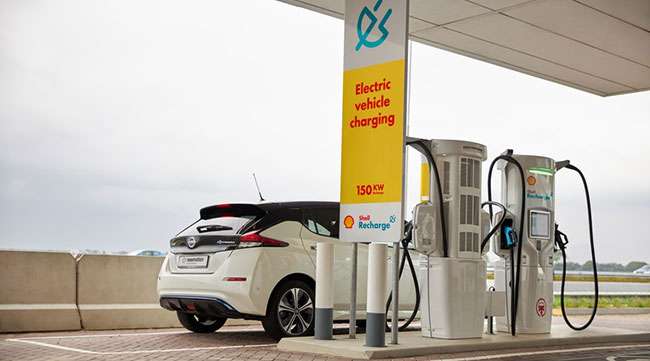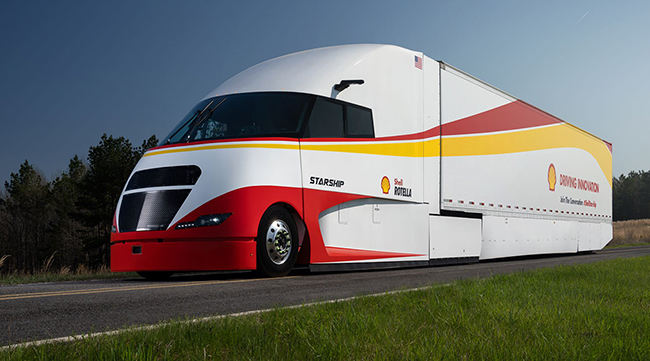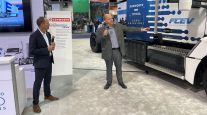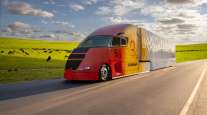Senior Reporter
Shell, Meritor Make Case for Lower Emissions

[Stay on top of transportation news: Get TTNews in your inbox.]
LONG BEACH, Calif. — Shell and Meritor Inc. have withstood abrupt changes in an evolving transportation industry because of their ability to adapt to new technologies.
Shell, a multinational oil and gas company, has 45,000 retail fueling locations, an infrastructure ready-made to eventually dispense hydrogen and offer electric charging. Meritor, with a 65% share of traditional axles in the diesel-powered Class 8 North American market, will put electric powertrains into series production later this year after five years of testing.
Both companies, in business for more than 100 years, remain nimble enough to meet the emerging zero-emission and low-carbon future, their executives told Transport Topics during interviews at the Advanced Clean Transportation (ACT) Expo on Aug. 30-Sept. 2.
T.J. Reed, Meritor's vice president of Business Development for Electrification, addresses industry colleagues at #ACTExpo. #BlueHorizon #ePowertrains #RunWithTheBull pic.twitter.com/pxbSHre1YH — Meritor (@Meritor) September 1, 2021
“It’s not a question of if. It’s more of a when and how,” T.J. Reed, Meritor vice president of global electrification, said of going in new directions with zero emissions.
Selda Gunsel, vice president of global commercial technology of Shell Global Solutions (US) Inc., agreed. “We need to be part of the transition. Otherwise we will be obsolete.”
She said Shell’s energy transition involves multiple options — biofuels, electric charging, natural gas, renewables, hydrogen refueling (underway as part of a pilot project at Los Angeles area ports) and lubricant, especially for battery-electric transmissions.

Gunsel
“This is a really big focus at Shell.” Gunsel added.
Shell, formally Royal Dutch Shell, is headquartered in the Hague, Netherlands.
At Troy, Mich.-based Meritor, core competencies in the electrification space, are its “advance gearing technology and, really, an understanding of heavy-duty applications,” Reed said.
That includes the electric motor, transmission and powertrain control module nested into one package, to meet what Reed called a tectonic shift.
Meritor faces competition from other well-known powertrain suppliers such as Cummins, Allison and Dana — all more than 100 years old, too.
“But with our strength with the fleets and the OEMS, we’ll have our fair share,” Reed said.

Fleet managers find that healthy, happy drivers are key to business success. Stephen Kane of Rolling Strong says driver health starts with “being vulnerable enough to listen to somebody that knows about health.” Hear a snippet above, and get the full program by going to RoadSigns.TTNews.com.
He pointed out that, besides funding, fleets looking to add electric trucks need to resolve basic issues including:
• How does an electric truck impact the duty cycle?
• Can fleets run the same number of shifts?
• What’s the residual value?
• What do they do with batteries after five years?
• What is the maintenance impact?
• How do they need to train people?
• How much does charging cost?
• How do they calculate the cost per mile and put rates together?
“I think the easy one is — drivers love [electric trucks],” he said.
He noted, though, there still is going to be a significant amount of clean diesel, too. And eventually hydrogen used for linehaul applications.
Meanwhile, behind Gunsel, was the Shell Starship 2.0. An 18-wheeler, completely skirted with a plunging nose and outfitted with the latest lubricant, components and technologies. The diesel truck has proved it is possible to achieve significant improvement in freight efficiency and fuel efficiency in trucks now on the road, she said.
Think of it as like systems engineering, she said, “bringing all of the parts together to optimize efficiency.”

The Shell Starship's recent trek from San Diego to Jacksonville, Fla., and a shorter 400-mile run were monitored and verified by the North American Council for Freight Efficiency. (Shell)
The truck, a project of Shell Lubricant Solutions, made a recent cross-country drive from San Diego to Jacksonville, Fla., following the same route as in 2018. A second, shorter 400-mile evaluation run was conducted to provide additional data about its freight-ton efficiency and fuel-economy benefits. Both trips were monitored and verified by the North American Council for Freight Efficiency.
Cross country, it achieved 254 ton-miles per gallon for freight-ton efficiency — a 3.5-times improvement over the North America average freight-ton efficiency for trucks of 72 ton-miles per gallon.
It posted 10.8 mpg on its cross-country trek compared with 8.94 achieved by Starship 1.0 and the 6.4 mpg North American fleet average.
On the shorter run, the average fuel economy was 12 mpg and the freight-ton efficiency value was 210 ton-miles per U.S. gallon.
Less fuel burned means fewer emissions.
Shell’s corporate target is to be a net-zero energy business by 2050.
That will require partnerships, Gunsel said, the right policies and incentives to make hydrogen fuel cells and battery electric vehicles a reality.
Want more news? Listen to today's daily briefing below or go here for more info:




